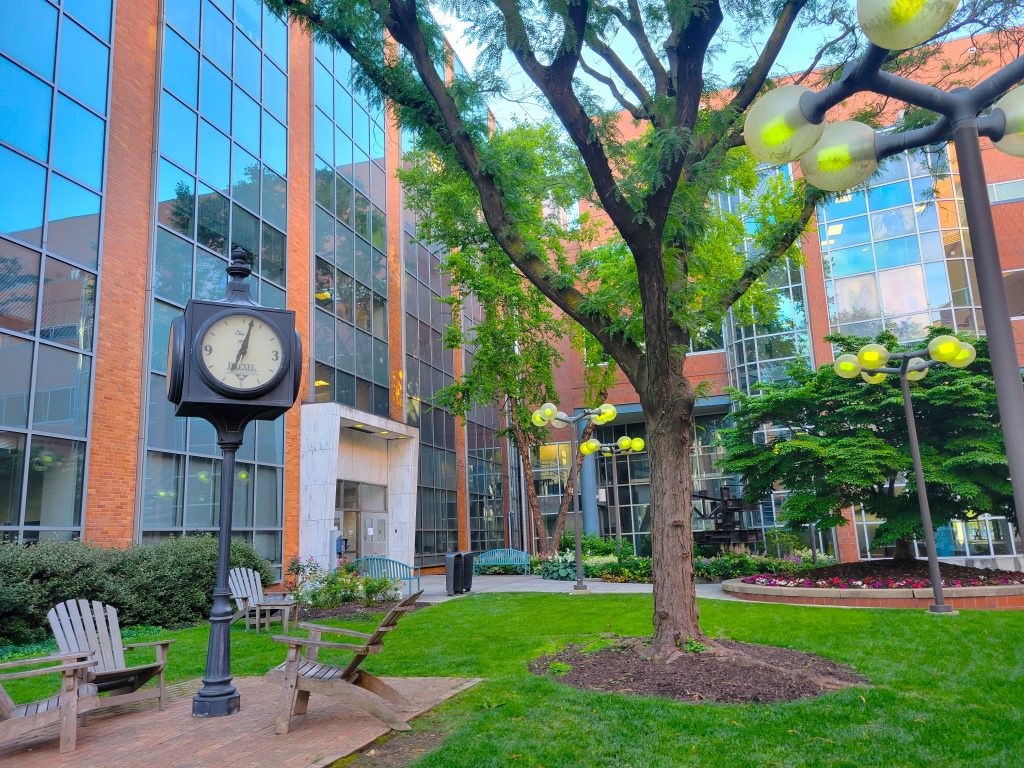
On May 29, Engineering Technology seniors presented their Senior Design projects. Over the course of their senior year, students worked in teams to engineer a solution to a specific problem. Projects covered multiple industries, including manufacturing, health, education and combating carbon emissions.
The Engineering Technology program began with presenting Haas-sponsored scholarships to five students, selected based on essays submitted about their interest in pursuing a career in manufacturing.
Seniors then stood next to their projects and poster boards. Attendees and faculty walked around to learn about each project and hear how they designed their solution. Seniors then gave presentations detailing their design process and answered questions.
“Senior design mimics a product development process and incorporates experiential aspects of our program, which is more applied and hands on,” shared Dr. Ertekin, the associate director of engineering technology. “Students at the end produce a working prototype while applying theoretical knowledge and learn from their mistakes what not to do in actual industrial settings. They also develop soft skills like project management, communication and teamwork skills.”
One group partnered with IFM Electronic to build a machine-vision system to minimize errors in assembly processes. IFM is a global company that specializes in manufacturing and sensors, aiming to improve efficiency and reliability. Through the partnership, IFM sponsored the student project, covering the $30,000 cost.
Their project incorporates two 3D-sensing cameras along with RFID detection for managing the assembly process. Attendees tried out the system and were intuitively able to follow the instructions on screen to assemble a pen. The cameras and RFID detection work together to ensure the operator follows the correct assembly steps to complete the assembly process without mistakes.
“I feel accomplished to a degree because I was working with professionals and I got first hand experience” Yahya Abdulrasool, one of the team members, shared. “Communication is key, especially when working with people you’ve never worked with before.” In total he estimates that it took two and a half months of work on the prototype after nine months of research.
Another group shared that they didn’t know what they should do for their project at first. “We asked people in other industries what issues they had that we could solve. Since many of my friends are nurses, we looked towards the health industry,” shared Pitchapa Inroon. They found that many hospitals are short staffed, especially in the wake of the Covid-19 pandemic, and some tasks are suffering because of it. According to their executive summary, their project is designed to address a “labor-intensive aspect of frequent repositioning of bed-bound patients to prevent complications like bed sores… our project focuses on developing a bed system utilizing individually inflatable air cells with pressure-sensing capabilities.”
Currently, repositioning requires two nurses to use a trendelenburg bed to tilt the bed downward, then slide the patient down. The team shared that this process is both time consuming and dangerous as patients may hit their head on the headboard. Their design automates the patient repositioning process and allows for pressure management.
Another senior project focused on making robotic education more accessible to schools. “Modern manufacturing and iteration tools are large and expensive, so they can be cost prohibitive for schools,” shared Aaron Kane. “We wanted to build an open source project that can teach the same manufacturing and coding concepts at an affordable price.”
Kane and his team built an ‘Educational Automated Manufacturing Workcell’ for students to experiment with robotics programming, and use the hands-on work cell to learn key concepts. “I’m glad to have been part of a team taking the initiative to help make automation training more accessible to Engineering Students around the world,” said Kane.
“The students start with a dream, and we [advisors and I] help them scope the dream to become reality without clipping their wings. They dream big and they should do so every day,” shared Dr. Irina Ciobanescu Husanu, associate clinical professor, engineering technology program director and senior design coordinator. “It is not an easy task, I wouldn’t trade it for another course. I can’t wait to see what’s in store for next year.”


